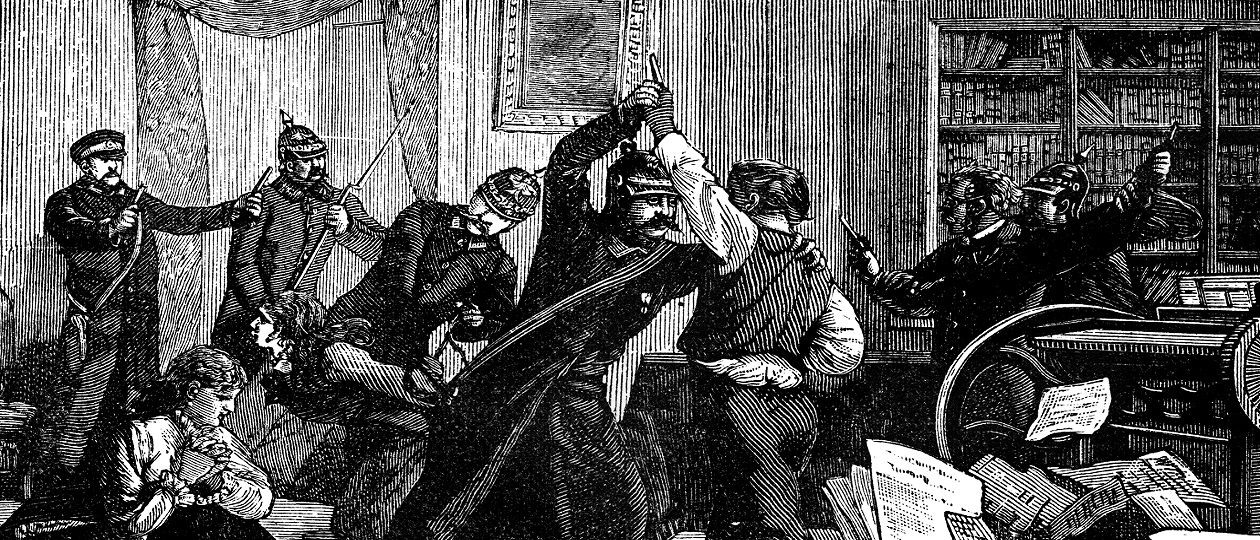
Political terrorism was born in Europe in the 19th century and the Russian Empire was the birthplace of mass terrorism.
Europe, Russia, and Political Terrorism
However, the history of political terrorism in the Russian Empire is still badly integrated into the history of Europe just as it is poorly integrated into the history of world terrorism. The same issues, pointed out in the previous article, are the major obstacles to integrating Russian narrative into the European historical narrative. These issues include terminology, definitions of terrorism, and distinguishing terrorism from other types of political violence.
The 19th century began with a royalist attempt on the life of Napoleon Bonaparte on December 24, 1800 (new calendar). In 1853, German radical Karl Heinzen, often called the father of terrorist theory, proclaimed <<The road to humanity leads over the summit of cruelty. This is the inexorable law of necessity dictated to us by the reaction. We cannot evade it, unless we would renounce the future. If we would accomplish the end, we must use the means. If we would secure the life of the people, we must secure the death of its enemies; if we would vindicate the life of humanity, we must not shrink—from murder … I preach the murder of despots openly, because it is a right, because it is a duty, because it is the only means to save humanity from the rule of murder, and because it must be acknowledged to be universally permitted and just. According to Heinzen, to save millions of people from tyranny, revolutionaries had to kill thousands of the people’s enemies.
Terrorism in Europe has gone through several stages in which the number of countries affected by terrorism and the ideological tendencies of terrorist organizations have varied in each stage. The first major stage of terrorism was the <<Era of Dynamite>> approximately between 1870-1914. This coincided with the three stages of terrorism in the Russian Empire between 1866-1911.
However, European terrorism in its early stages in the 19th century had a long prehistory going back centuries. The prehistory included:
- Organized murders by different ancient and medieval political-eschatological sects, for example, the Judaean Sicarii and the Muslim Assassins. Historians often regard the Sicarii and Assassins as the first terrorists.
- Long traditions of regicide and tyrannicide—killings of monarchs and tyrants. Europeans could find many cases and justifications of regicide and tyrannicide in the Old Testament of the Bible.
- Philosophical and theological debates in ancient times, the Middle Ages, and Early Modern Europe often justified regicide and tyrannicide.
- The glorification in literature, folklore, and music of tyrannicides and people’s avengers as heroes. The most stunning example was the Swiss patriot William Tell who killed the Austrian tyrant Albrecht Gessler in 1307 with one shot of an arrow. Members of the People’s Will stated that they would use the method of William Tell to put an end to tyranny.
- The glorification in folk culture in all European countries, including Russia of << noble bandits>>, like Robin Hood in England who stole from the rich to give to the poor. The noble bandit, like a terrorist, was a person outside the law but who had his or her own ideas about social justice, national dignity, and the overthrow of tyranny. Bandits were also glorified in literature.
- The development of a culture of violence in Europe. Beginning in the late 18th century and continuing right up to the First World War, theatre audiences could see plays and operas glorifying regicide people’s avengers, noble bandits, people’s uprisings, revolutionary conspiracies, national struggles for independence, eschatological movements, religious wars, and other manifestations of politically motivated violence.
- The influence of eschatology—a religious teaching in Zoroastrianism, Judaism, Christianity, and Islam about the coming end of the world. Through violence against their earthly enemies, followers of eschatological sects could speed up the end of the old world and the coming of a new age. Beginning with the French Revolution, eschatology took on political overtones and shaped nearly all European ideologies and influenced European revolutions.
The culture of violence was intensified by several waves of revolutions in Europe between 1768-1922. Participants in revolutionary, antirevolutionary, and counterrevolutionary movements came to regard violence as a completely legitimate means of political struggle. The waves of European revolutions included:
- The first wave, 1768-1815: This is the era of the French Revolution and other democratic revolutions, especially in Belgium, Holland, Switzerland, Germany, and Italy. There was also revolutionary turmoil in Great Britain, Ireland, the Austrian Empire, Poland, and other countries. During the reign of Emperor Napoleon Bonaparte, there were many anti-French and national-liberation uprisings and wars in Spain, Germany, and other countries.
- The second wave, 1815-1847: This wave included revolutions in Italy, Spain, and Portugal in 1820, the Greek war of independence from 1821-1830, the Decembrist in Russia in 1825, revolutions in France and Belgium in 1830, the Polish uprising of 1830-1831, revolutionary outbreaks in several German and Italian lands in the early 1830s.
- The third wave — European revolutions between 1848-1851. Participants in the revolutions included liberals, radicals, socialists, nationalists fighting for autonomy or independence. There was political turmoil in countries not undergoing revolutions, including Great Britain and the Russian Empire.
- The age of classical European revolutions ended in 1871 with the destruction of the Paris Commune. Marxist and Soviet historians argued that the Paris Commune began a new era of proletarian (working-class) revolutions, but the Commune had more elements of similarities, than differences, with the classical European revolutions.
- Political turmoil in Europe continued after the suppression of the revolutions of 1848-1851. Spain experienced several civil wars because of conflicts about the succession of monarchs and struggles between the center and regions. The wars of unification of Germany and Italy included elements of political civil war. There were also national-liberation movements and wars, especially in the Balkans. These wars often combined political, social, ethnic, and religious aspects and usually included elements of civil war. The abolition of serfdom in 1861 in the Russian Empire began waves of revolutionary and oppositional movements. Everywhere in Europe, political parties across the spectrum were formed. Ideological conflicts intensified and anarchist and nationalist terrorism broke out in several countries. The major revolutions of the early 20th century included the Russian Revolution of 1905-1907, revolutions in the Ottoman Empire in 1908, and Portugal in 1910.
- The Russian Revolution of 1917-1922 — this includes the February and October Revolutions of 1917 and the Civil War — was the culmination of waves of European revolutions. The Revolution of 1917-1922 launched a new wave of revolutions and ideological conflicts in Europe.
The Russian Revolution of 1905-1907 was the first major European revolution with a terrorist component.
Europe’s and Russia’s Stages of Terrorism
Europe has gone through several stages of terrorism since the 1800s. As noted in a previous article, terrorism in the Russian Empire went through several stages of terrorist activity and several lacuna-periods when terrorism was not used but still was discussed as a means of political struggle.
Outbreaks of terrorism in Russia began April 4, 1866, with an attempt on the life of Tsar Alexander II by D. V. Karakozov, a member of the group <<Organization>>, led by his cousin N. A. Ishutin and ended with the assassination of Prime Minister P. A. Stolypin by D. G. Bogrov, a revolutionary and police agent.
The stages and lacunas included:
- A beginning stage from 1866-1869 with a pre-history starting in 1864. The major groups were <<Organization>> with its inner circle <<Hell>> and the <<People’s Vengeance>>, led by S. G. Nechaev. Major terrorist acts were Karakozov’s attempted assassination of Alexander II in 1866 and the murder of student I. I. Ivanov in November 1869 by Nechaev and other members of <<People’s Vengeance>>.
- First lacuna-period from 1870-1878. This period coincided with the blossoming of revolutionary populism with its culmination in the <<Going to the People>> in 1874. In 1876, populists organized <<Land and Freedom>> and this revolutionary organization had a disorganizing group for the defense of revolutionaries from traitors, spies, and cruel officials.
- The first wave of terrorism from 1878-1894. This period began January 24, 1878 with an attempt by V. I. Zasulich on the life of St. Petersburg Governor F. F. Trepov and her acquittal by a jury. Revolutionaries from Land and Freedom and other groups killed or wounded several police spies and officials. Beginning in 1879, the People’s Will became the dominant terrorist organization. Members of the People’s Will assassinated Tsar Alexander II on March 1, 1881. Almost all revolutionaries of the period called themselves members of the People’s Will although the organization was destroyed by 1884. All attempts between 1884-1894 to restore the People’s Will failed.
- The second period between1894-1900. This period included the formation of political parties and movements, especially the Party of Socialists-Revolutionaries who considered themselves the heirs of the People’s Will. Revolutionaries discussed using terrorism as a means of political struggle.
- The second wave of terrorism from 1901-1911. This was a crowded playing field of participating. Participating parties and movements included Empire-wide parties of Socialists-Revolutionaries [SRs], Social Democrats — both Bolsheviks and Mensheviks —, SR Maximalists who split from the SRs in 1906; Anarchist groups of Anarcho-Communists, Anarcho-Syndicalists, and Anarcho-Individualists; marginal leftist groups who had no party affiliation; ethnic minority Marxist and Populist parties, largely among Poles, Jews, Armenians, and Latvians; the right-wing Polish National Workers Union; Black Hundred fighting squads from the Union of the Russian People and other far-right organizations.
- The third period from 1911-1914. SRs, anarchists, Polish, Armenian, Latvian, and Finnish tried to restart terrorist activities.
Note that terrorism never vanished from the agendas of Russian revolutionaries from the 1860s right up to the February Revolution of 1917.
The stages of political terrorism in European countries include:
- A preliminary stage from approximately 1800-1870. This stage began with a royalist attempt on the life of Napoleon Bonaparte on December 24, 1800 [new calendar] and included terrorist attacks by groups and individuals on the lives of monarchs and other rulers. A noticeable terrorist act was the attempt by Italian nationalist Felice Orsini and his group on the life of Emperor Napoleon III on January 14, 1858.
- The first stage — the <<Era of Dynamite>> between 1870-1914. Anarchist terrorists were most active in Spain, Italy, and France while nationalist terrorists were active in Ireland, the Balkans, and the Ottoman Empire.
- The second stage runs between the end of World War One in 1918 and the beginning of World War Two in 1939. Leftist, rightist, and nationalist groups predominated with nationalism spanning the political spectrum from far right to far left. Many paramilitary groups, mostly right-wing, between 1917-1923 carried out terrorist attacks in Ireland, Italy, Germany, Poland, and the Balkans. Spain in the 1920s had both anarchist and anti-anarchist terrorist groups and both sides often used common criminals to carry out terrorist attacks. There were Communist fighting squads in different countries under the leadership of local Communist parties and the Communist International [Comintern] carrying out terrorist attacks against Trotskyites, anarchists, and other leftist dissidents. Russian White émigrés committed terrorist acts against representatives of the Soviet government.
- Partisan and other resistance movements during the Second World War often used terrorism against occupying forces, collaborationists, and other enemies. Collaborationist groups also used terrorism against members of the resistance and other opponents. However, terrorism never became the main form of struggle among both resistance and collaborationist movements. Terrorist continued for several years after the end of World War Two in 1945 and it was used largely by insurgent movements in certain countries, for example in Western Ukraine and the Baltic states in the Soviet Union.
- A huge wave of terrorism swept Western European countries and Turkey [a member of NATO] in the 1960s to 1980s. Leftist, rightist, and nationalist terrorist groups emerged in many countries. Terrorism in Europe took on global dimensions with Palestinians, Latin Americans, Japanese, and radicals from other parts of the world conducting terrorist operations. There were terrorist groups that combined rightist and leftist elements. Terrorist groups shared a common hatred of democratic forms of government. As American scholar Jeffrey M. Bale noted, rightist and leftist groups both deliberately used terrorism to provoke governments into increasing repressions. Rightists hoped to establish a dictatorship, while leftists hope that increasing repression would finally trigger a mass revolution. Both American and Soviet publicists accused each other’s governments of sponsoring terrorism.
- The current stage of European terrorism began after the collapse of the Soviet Union and other Communist states from 1989-1991. The geography of countries affected by terrorism has widened to include all European states and post-Soviet republics. Islamist and far right organizations are the main players in current European terrorism although leftist and nationalist groups still participate.
In the next article, we will look at how many trends in political terrorism in the Russian Empire foreshadowed trends in European terrorism, especially in the 1960s to 1980s.
Citations
- Российская революция 1905–1907 гг. и европейская «Эпоха динамита»: вызовы к конструкции общеевропейского исторического нарративa о политическом терроризме. (The Russian Revolution of 1905–1907 and the European «Era of Dynamite»: challenges in constructing a common European historical narrative of political terrorism) // Мир оружия: история, герои, коллекции: Сб. матер. IХ Междунар. науч.-практич. конф. 27–29 октября 2021 г. Тула, 2022, сс. 435–446.
- Heinzen, Karl. Murder and Liberty. Printed for the first time as a contribution for the “Peace League” of Geneva. Indianapolis IN: sold by H. Lieber, 1881.
- Рокки, Энтони Карл. Периодизация истории политического терроризма в Российской империи между 1866–1911 гг.: элементы преемственности и перемен. (Periodization of the history of political terrorism in the Russian Empire between 1866-1911: elements of continuity and change). Гусевские чтения — 2023. Три измерения политической истории России: идеология, политика, практика. Сборник научных статей по материалам Всероссийской научно-практической конференции(с международным участием). Москва, 2023, сс. 107-124.
- Bale, Jeffrey M. Right-Wing Terrorists and the Extraparliamentary Left in Post-World War II Europe: Collusion or Manipulation? Berkeley Journal of Sociology, vol. 32 (1987), pp, 193-236.
- Terrorism https://www.europol.europa.eu/crime-areas-and-statistics/crime-areas/terrorism





